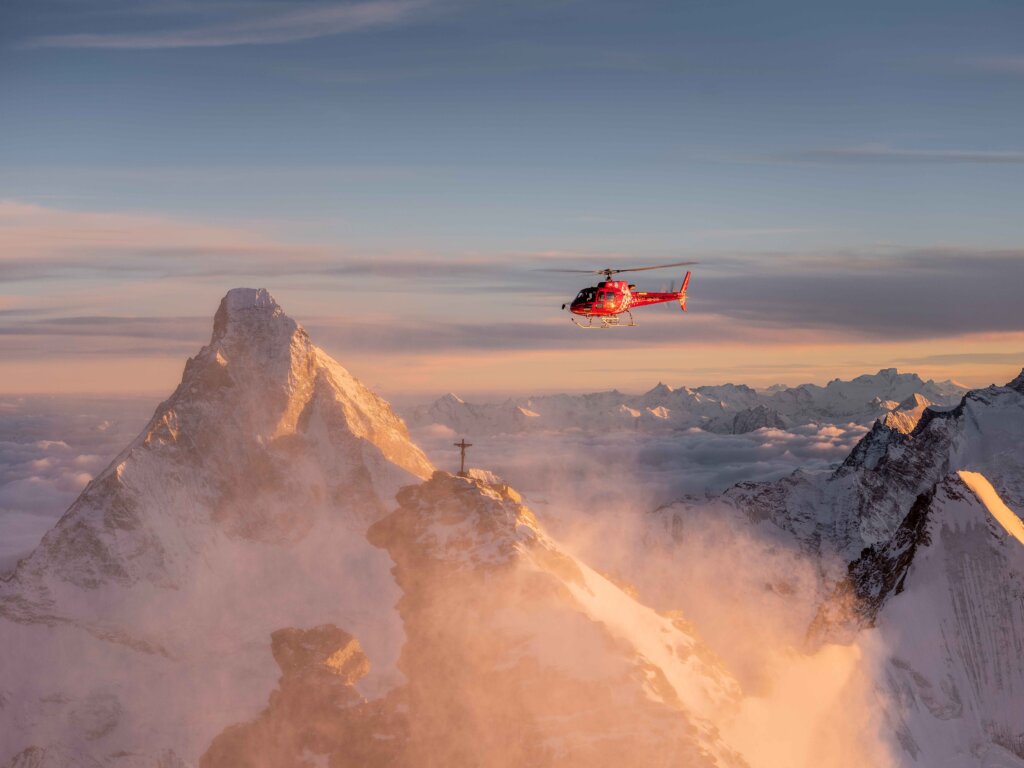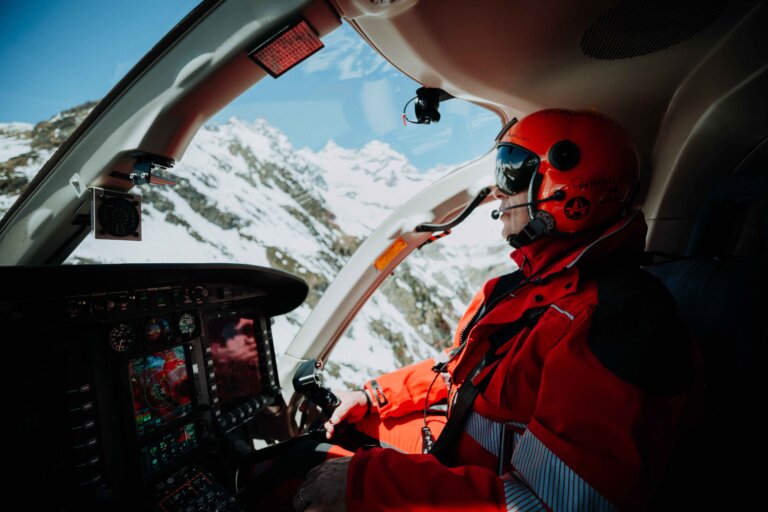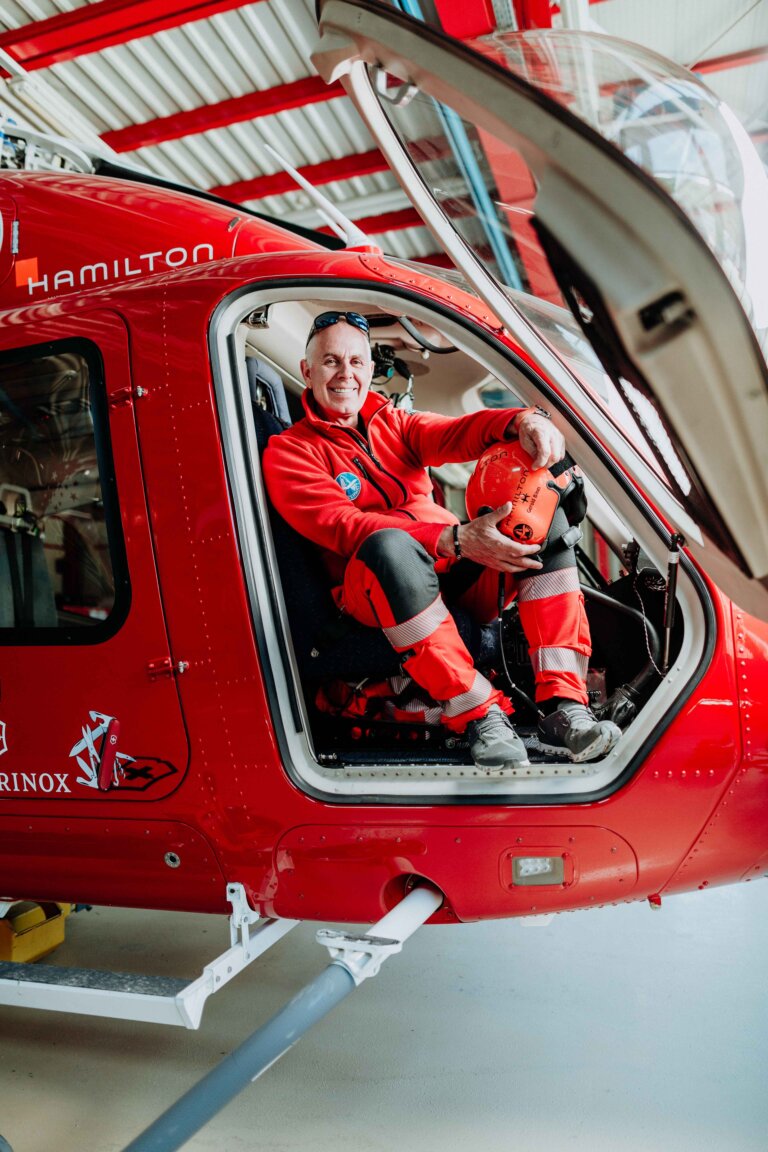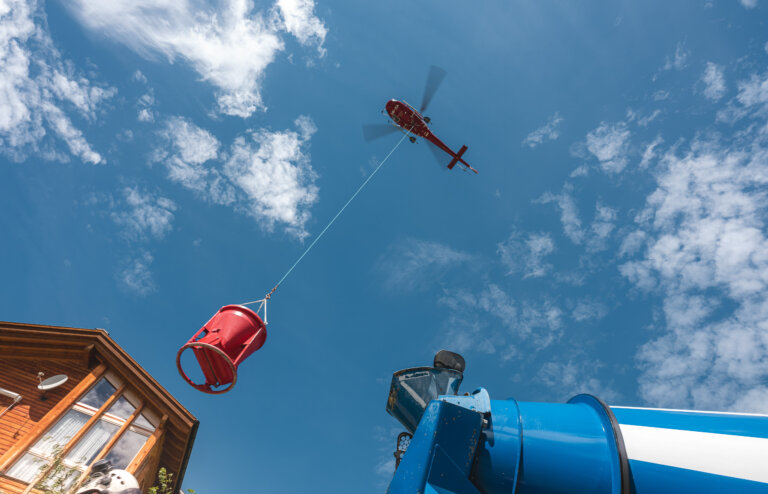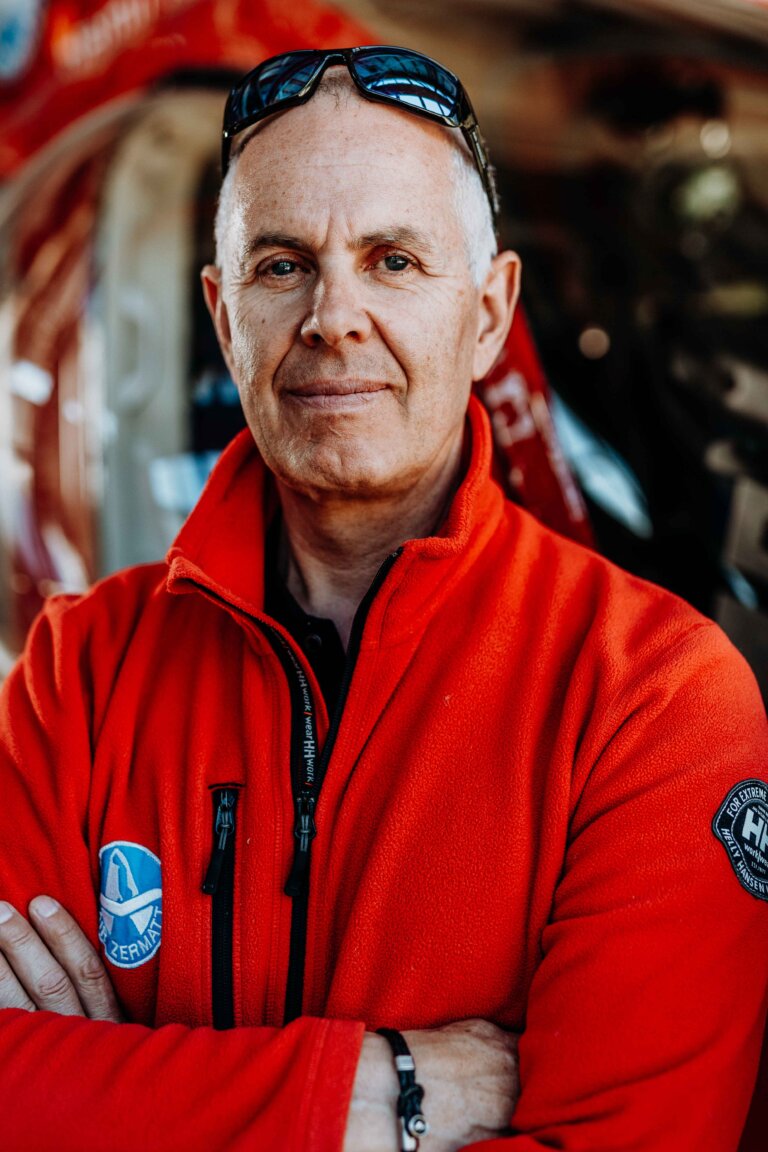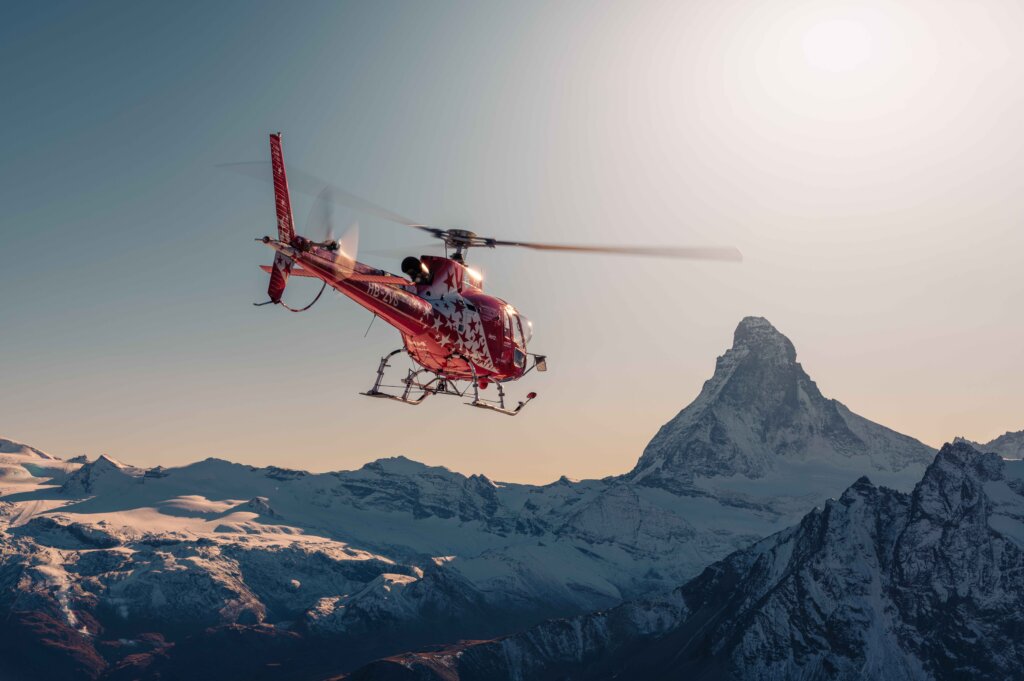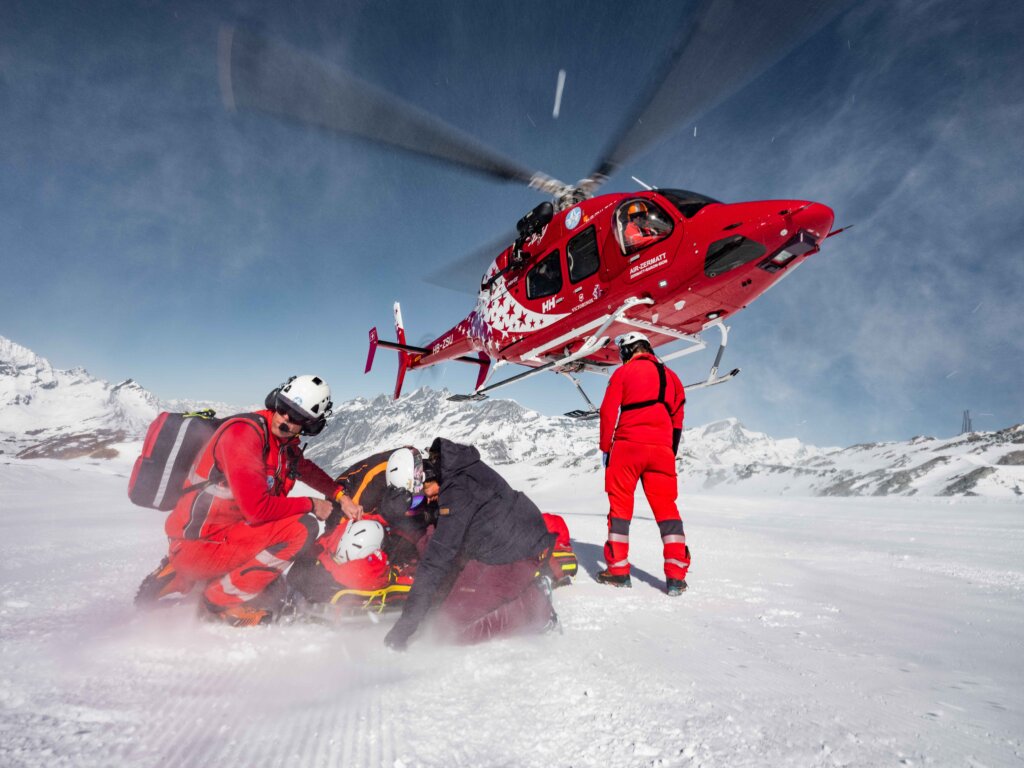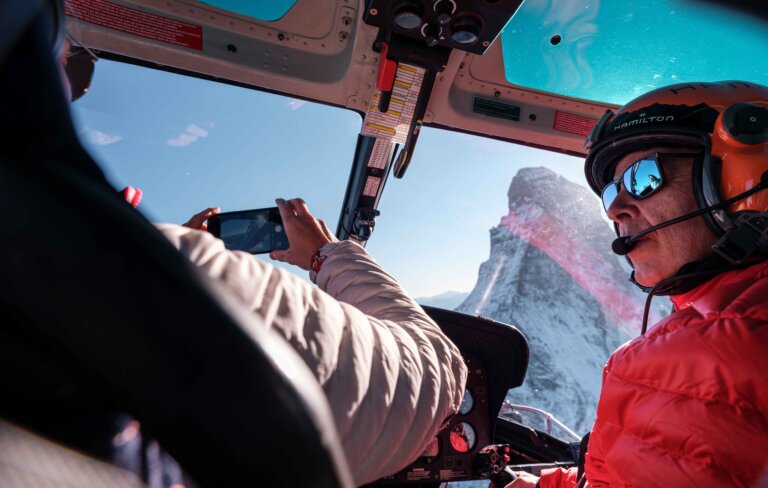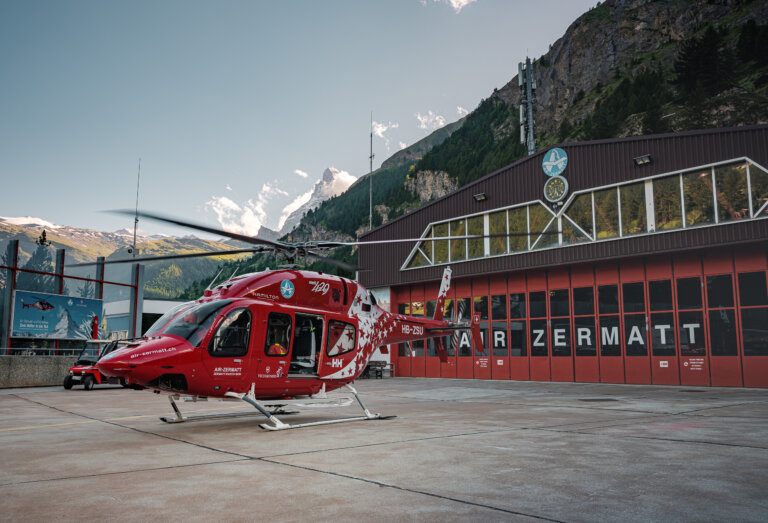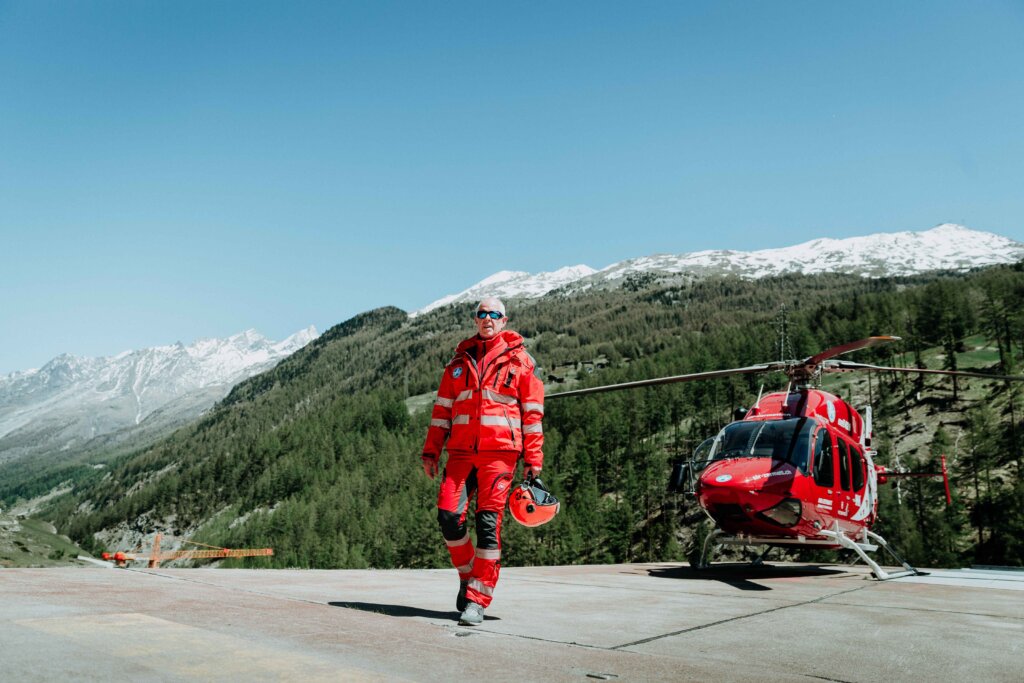Above left and centre – © Atem Collective
Above right – © Christian Pfammatter
Immediately recognisable by their distinctive red and white stars, the Air Zermatt helicopters are a symbol of reliability, speed, and innovative Swiss technologies.
Founded in 1968 with just a single helicopter, a pilot and a mechanic, Air Zermatt is now a thriving company that boasts some of the world’s finest pilots, SAR flight paramedics, emergency medical technicians, task specialists, mechanics, dispatchers, and administrative staff.
Initially focusing solely on air rescue operations, the company has since extended its offering to include all kinds of transport needs and tourist flights with its fleet of eleven state-of-the-art helicopters.
In addition to offering their expert skills to the public, Air Zermatt also boasts a world-class flight school to help inspire and refine the next generation of talented pilots who already hold a commercial or private license. At the Air Zermatt Training Center (ATC), pilots can learn about emergency medicine and alpine rescue from a diverse training team with vast combined experience. With specialists from every area of rescue operations through to continuing education in flight schools for professional pilots, the comprehensive range of training makes the ATC a one-of-a-kind provider.
With such an impressive track record and faultless reputation, FOUR speaks to Gerold Biner, CEO and pilot at Air Zermatt AG, to find out what makes Air Zermatt so successful and what else the unique flight specialist offers.
Above left – © Atem Collective
Above right – © Christian Pfammatter
Tell us a bit about the history of Air Zermatt and how you became CEO of the company Air Zermatt?
Back in the sixties, Zermatt has already been established and well known as an international resort for tourists. However, as the number of people accommodated in the village increased, so did the demands and problems, ranging from infrastructure to medical care. After some local resistance and hurdles to overcome, Air Zermatt AG was finally founded on August 3, 1968, by Beat Perren with the support of Constant Cachin, the tourism director at that time. As promised to the local population, the company’s main activity was rescue evacuation and other aid flights. The years that followed were marked by pioneering achievements that continue to have a substantial impact on aviation to this day. With innovation, courage and will, Beat Perren and his company were forerunners and inventors of some of the most important techniques and means in alpine air rescue. In addition to the positive developments, the company has also experienced the negative aspects of rescue services. Non-payment of rescued people, own accidents and enormously increasing cost-intensive regulations and bureaucratisation of European aviation impacted the company’s financial stability. Through economic intelligence and untiring personnel, this imbalance was overcome so that Air Zermatt presents itself as a broadly diversified and stable company today.
My fascination for flying began at a very young age. My friends and I often visited the base at the village entrance and watched helicopters flying in and out the whole day, dreaming of being the captain of one of these ships one day. A heartfelt wish in childhood which then became a reality. From training as a mechanic to pilot to CEO, it has been an exciting journey filled with incredible, unforgettable, and tragic experiences. As the CEO position became vacant in 2012, I saw an excellent opportunity to step ahead and bring together all the experience I have gained and the passion I have for this company. My application was critically reviewed, and other options were weighted – however, in the end, I was elected to the position.
Can you explain a bit about the services Air Zermatt offers?
As stated in the company’s statutes on the day of the foundation 54 years ago, air rescue has always been and will always be the main focus. In addition to the need for medical care, a need for commercial flights has also developed in the region over the years. Topographical conditions fueled the need for easy, fast, and efficient transportation, which translated into demand for commercial flights. In addition, a wide range of services are offered to the clientele visiting the Valais and Zermatt in particular, be it airport transfers or exclusive experiences around the Valais Mountain region. Through years of experience and the unique quality standard of the rescue operation and our personnel, the market for training has opened locally as well as internationally. The Air Zermatt Training Center offers a wide range of courses conducted by its own instructors, from basic life support training to advanced Mountain Emergency Medicine courses and advanced flight school courses.
What makes the company so special, in your opinion?
Several factors make our company very special.
Air Zermatt has become a brand that stands for Swiss quality. Mainly in the rescue domain but certainly also the incredible quality in the maintenance of our helicopters thanks to our in-house maintenance. Many different professions come together – from medical staff to technical and administrative professions, which generates an incredible exchange of know-how. The disciplines must be able to work together, requiring a certain basic knowledge or understanding of all other domains.
During the year, we experience fluctuating demand; hence, times may be very intense. Our staff is then strained, and what you need is reliable, efficient, and accordingly fitting people. Whoever works here must have an extraordinary passion for the cause and a will to work hard during high times; otherwise, you’re in the wrong place.
Even though the company has grown continuously, it remains very familiar, and people know each other and cross paths outside work. Many great young new people bring fresh wind into the company and are also offered the opportunity. Again, Air Zermatt can proudly count on long-time employees who have incomparable value for the company. Not only the company benefits from the cooperation of the generations, but also the people themselves because experience and knowledge intersect with new ideas and new ambition. It is inspiring, offers employees countless opportunities to implement changes, and avoids knowledge gaps. Our culture is open, family-like and the purpose of the whole organisation is to do good, and that is what we are all here for every day – you don’t find that kind of connection to work just like that anymore.
Another very important and interesting fact is the efficiency and resource allocation Air Zermatt implemented. In today’s world, the debate about resources is important. If you look at companies financed by the state or benefactors, efficiency is simply non-existent. Mixed operations, as found at Air Zermatt AG and Air-Glaciers SA, are probably one of the most efficient systems in aviation. Since resources have to be deployed in the right place, the entire process, from planning to implementation, is at a very high level of efficiency and correct resource allocation. The wide deployment of our pilots generates indirect training for sharp missions in challenging terrain with every flight. Capital flows to the right place, resources are appropriately deployed, and thus quality and safety are ensured. This is a simple economic principle that is lost by state-owned companies that are financed by the public purse.
Can you tell us your favourite highlights of the Air Zermatt facilities, aircraft and journeys?
After close to 40 years of working for one company, it’s hard to pick a single highlight, and I find the whole journey of the company awe-inspiring rather than just one highlight itself. During my time as a pilot of Air Zermatt, I had the privilege to fly many different types of helicopters such as Puma, Lama and today, the powerful AS350, B3, and the Bell 429. Each one of these machines has its appeal and contributes to the experience and learning curve. Likewise, we were served many unbelievable opportunities to fly worldwide. Whether firefighting in Portugal, flying in the Indian and Nepali Himalayas or somewhere in the United States, Africa or anywhere else in the world– Air Zermatt as a company had huge impacts all over the world, and it was and still is fascinating being part of it all.
Tell us about the current Air Zermatt team and the latest offerings?
Currently, Air Zermatt AG employs about 75 people at its three bases in Zermatt, Raron and Gampel. Both the fleet and the personnel are consistently adapted to the needs of the operation. At present, however, a somewhat cautious attitude towards job applications is noticeable in our ranks, just like in the whole job market. Nevertheless, we are very well positioned and can rely on our excellent staff.
We continue to be at the forefront of innovation, evident in our latest investment, the VRM Simulator. It is used for customer and internal training purposes and is one of the exciting technological advancements in the aviation market.
The innovative spirit of the previous generation is still anchored in Air Zermatt’s philosophy. For example, employees of Air Zermatt have developed a new system for changing aircraft warning spheres on high-voltage power lines, which is now being successfully implemented. Beat Perren is also still full of energy and ideas and has recently developed a new system for fighting fires, which has now also been certified.
Air Zermatt is working relentlessly on creating offers to meet the demand and adapt to new regulations without losing profitability which is indispensable for a private company. Thereby, a broad portfolio of offerings has been established over the years.
What are the most important things for clients when using Air Zermatt, and how do you factor this into the overall experience?
No matter how you use the offerings of Air Zermatt, the weather is a deciding factor. Whether it is a sightseeing or taxi flight, commercial flight or rescue mission, a certain amount of flexibility is required regarding the weather. During courses in the Training Center, the program needs to be adapted from time to time – helicopters may be withdrawn from commercial or touristic flights for urgent rescue missions. However, if you can stay adaptable, you will undoubtedly get the best out of the experience.
Thanks to the efficiency of our resources, our company can adapt instantaneously to all upcoming circumstances. The focus remains on the rescue service, which is always treated with the highest priority. What other rescue companies cannot offer is the number of deployable rescue means that can be provided in the shortest possible time. For the rescue service in the canton of Valais, this is an incredible quality factor that many people are unaware of. However, this enormous benefit for the local population and the people visiting our area presupposes a certain amount of understanding of our work and the background of the company. Even if the plan is changed at short notice, the Air Zermatt dispatch will do everything in its power to find a suitable solution for all customers.
Following the credo “the sky is the limit” or, in many cases, “the jurisdiction is the limit”, a wide range of customer wishes can be fulfilled through the broad product portfolio of Air Zermatt.
Have you seen a difference in how people use aircraft over the years? And if so, how?
Of course, there are many different ways people are using our aircraft. Depending on the situation, the utilisation relates to a recreational experience, education or, in many cases, out of necessity. The sentiments ranging from pure happiness to tragedy are part of our daily business; you will see all kinds of emotional states in one day at our bases.
Naturally, this also changes each individual relationship with our company. For some, it is a life-saving remedy or a practical and helpful solution; for others, we provide an unforgettable moment. The variety of our customers is ridiculous, which makes it even more interesting to work here.
Of course, the challenge is ensuring that employees can deal with these emotions. Although most people who have flown in one of our helicopters are delighted and happy, some can cause problems, especially “afterwards”. Patients who deny payments, deliberately give false information, take the rescue missions for granted and are not even aware of their own mistakes – this can be very frustrating for our team.
Have you seen an increase in the number of people wanting to train to become pilots at the Air Zermatt training school?
Training for pilots has always been in high demand, which is why we have our own flight school offering advanced courses such as mountain training and type ratings. Our newest addition in the ATO is the Type rating for the Bell 429 – a novelty in Switzerland, which has increased demand once again.
Overall, the demand for pilots’ training has certainly increased over the last decades. Through the newest investment with our VRM Simulator, it might be even less cost intensive for new pilots in the future and hence increase demand even more.
Above – © Christian Pfammatter
What do you think will leave the biggest impression on clients who use Air Zermatt recreationally or otherwise?
Once again, there’s not one answer to that question. The helicopters themselves leave an uncanny impression on most clients. Compounded with the colouring, the stars on the back, and the whole corporate identity, Air Zermatt has created a brand that can be deeply locked into people’s heads. The cherry on top of the cake is the staff, from the flight attendants who are in contact with people daily to the paramedics and doctors and all the staff who are less on the front lines. The interaction of the technical and administrative staff in the background is often not quite visible but also contributes to the whole picture and the impression given to our customers.
In addition to what Air Zermatt can influence, there are also natural conditions from which we benefit and burn ourselves deeply into the memories of our customers. The mountains of the Valais Alps are, in my opinion, one of the most beautiful places in the world; seeing them from a bird’s eye is simply incredible and priceless.
Any upcoming developments that people can look forward to?
We have many exciting projects in our pipeline, and we suggest keeping updated through our social media channels. One sneak peek: In 2023, Air Zermatt celebrates its 55th anniversary.
Find out more about Air Zermatt and its wealth of extraordinary aviation offerings at www.air-zermatt.ch

